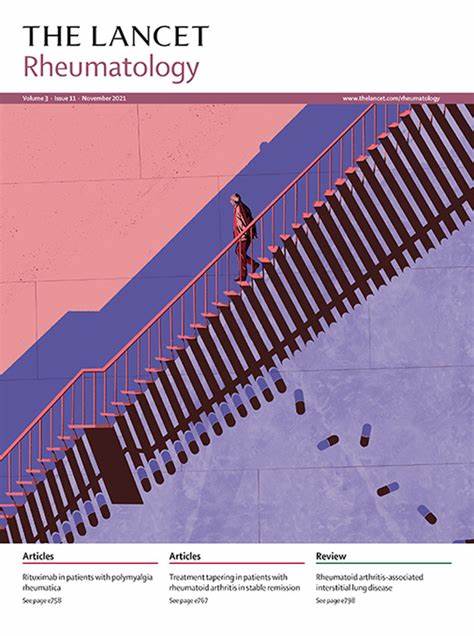血清I型干扰素评分作为弥漫性皮肤系统性硬化症患者疾病活动性生物标志物:一项回顾性队列研究
IF 15
1区 医学
Q1 RHEUMATOLOGY
引用次数: 0
摘要
背景:I型干扰素(IFN)通路激活与严重的系统性硬化症有关。我们旨在研究两组弥漫性皮肤系统性硬化症患者的血清 IFN 评分与疾病活动性和预后的关系:在这项回顾性队列研究中,我们纳入了参加美国早期系统性硬化症前瞻性登记(PRESS;事件队列)或英国观察性队列(硬皮病进展风险分级[STRIKE];流行队列)登记的弥漫性皮肤系统性硬化症成年患者(年龄大于 18 岁)和健康对照组(志愿者)。血清由 Myriad-Rules Based Medicine 的 Luminex xMAP Technology Multiplex Assay(美国德克萨斯州奥斯汀)进行分析,并利用 CCL2、CCL8、CCL19、CXCL9、CXCL10 和 CXCL11 的浓度生成 IFN 分数。当六种趋化因子的自然对数平均值之和大于(或在)健康对照组的两个标准差之内时,患者被归类为 IFN 高(相对于 IFN 低)。主要结果测量指标为基线和 12 个月时改良罗德南皮肤评分、强迫生命容量 (FVC)、一氧化碳弥散容量 (DLCO) 和健康评估问卷-残疾指数的最小临床重要差异。一位有系统性硬化症生活经验的人士参与了报告的撰写:PRESS事件队列中的弥漫性皮肤系统性硬化症患者是在2012年4月1日至2019年1月1日期间招募的,健康对照组和STRIKE流行队列中的患者是在2014年12月1日至2018年12月1日期间招募的。为 110 名事件队列患者(平均年龄 50-2 岁 [SD 15-0],76 [69%] 女性和 34 [31%] 男性,87 [79%] 白人)、72 名流行队列患者(平均年龄 51-7 岁 [SD 10-9],50 [69%] 女性和 22 [31%] 男性,64 [89%] 白人)和 32 名健康对照组(平均年龄 47-0 岁 [SD 12-4];19 [59%] 女性和 13 [41%] 男性;24 [75%] 白人)生成了 IFN 评分。在发病队列的 110 名患者中,有 50 人(45%)被归类为 IFN 偏高;在流行队列的 72 名患者中,有 27 人(38%)被归类为 IFN 偏高。在事件队列中,与 IFN 低的患者相比,IFN 高的患者的基线疾病更严重,评估指标包括平均预测 FVC(72-0% [SD 18-9] vs 85-3% [18-5];p=0-0028)、DLCO(56-8% [SD 21-6] vs 76-6% [25-3];p=0-0008)和健康评估问卷-残疾指数中位数(1-4 [IQR 0-8-2-0] vs 0-8 [0-4-1-5];p=0-0033)。FVC 和 DLCO 的差异在最后一次随访时仍然存在(FVC 的中位数为 34 个月 [IQR 19-8- 54-0],DLCO 的中位数为 34 个月 [IQR 22-5- 54-0])。与 IFN 低的患者相比,IFN 高的患者的中位病程较短(2-2 年 [IQR 0-7-8-2] vs 5-0 年 [1-9-10-0];P=0-035),12 个月的肺部预后较差,与基线 FVC 或免疫抑制无关(23 例 IFN 高的患者中有 9 例 [39%] FVC 相对恶化 5%,41 例 IFN 低的患者中有 7 例 [17%];P=0-051)。此外,IFN-高的累积 5 年死亡率为 24-9%(95% CI 14-9-39-7),而 IFN-低的累积 5 年死亡率为 8-6%(3-6-19-9)(P=0-052):对弥漫性皮肤系统性硬化症患者进行血清IFN评分评估,可识别出疾病活动度高的患者,这些患者的12个月预后和总生存期更有可能恶化:国家硬皮病基金会、美国国立卫生研究院国家关节炎和肌肉骨骼及皮肤病研究所风湿病研究核心中心、美国国立卫生研究院利兹生物医学研究中心和肯尼迪风湿病学研究信托基金。本文章由计算机程序翻译,如有差异,请以英文原文为准。
Serum type I interferon score as a disease activity biomarker in patients with diffuse cutaneous systemic sclerosis: a retrospective cohort study
Background
Type I interferon (IFN) pathway activation has been associated with severe systemic sclerosis. We aimed to examine the association of serum IFN scores with disease activity and outcomes in two cohorts of patients with diffuse cutaneous systemic sclerosis.
Methods
In this retrospective cohort study, we included adult (aged >18 years) patients with diffuse cutaneous systemic sclerosis enrolled in the US Prospective Registry of Early Systemic Sclerosis (PRESS; incident cohort) or in the UK observational cohort (Stratification for Risk of Progression in Scleroderma [STRIKE]; prevalent cohort) registries and healthy controls (volunteers). Sera were analysed by Myriad-Rules Based Medicine's Luminex xMAP Technology Multiplex Assay (Austin, TX, USA), and IFN scores were generated using concentrations of CCL2, CCL8, CCL19, CXCL9, CXCL10, and CXCL11. Patients were classified as IFN-high (vs IFN-low) when mean sum of the natural logarithm of the six chemokines was greater than (or within) two standard deviations of healthy controls. The main outcome measures were the baseline and the minimal clinically important differences for modified Rodnan Skin Score, forced vital capacity (FVC), diffusing capacity for carbon monoxide (DLCO), and Health Assessment Questionnaire-Disability Index at 12 months. A person with lived experience of systemic sclerosis was involved in writing the report.
Findings
Patients with diffuse cutaneous systemic sclerosis in the PRESS incident cohort were recruited between April 1, 2012, and Jan 1, 2019, and healthy controls and patients in the STRIKE prevalent cohort were recruited between Dec 1, 2014, and Dec 1, 2018. IFN scores were generated for 110 patients in the incident cohort (mean age 50·2 years [SD 15·0], 76 [69%] women and 34 [31%] men, 87 [79%] White) and 72 patients in the prevalent cohort (mean age 51·7 years [SD 10·9], 50 [69%] women and 22 [31%] men, 64 [89%] White), and 32 healthy controls (mean age 47·0 years [SD 12·4]; 19 [59%] women and 13 [41%] men; 24 [75%] White). 50 (45%) of 110 patients in the incident cohort and 27 (38%) of 72 patients in the prevalent cohort were classified as IFN-high. In the incident cohort, patients classified as IFN-high had worse baseline disease compared with patients classified as IFN-low, as assessed by mean predicted FVC (72·0% [SD 18·9] vs 85·3% [18·5]; p=0·0028), DLCO (56·8% [SD 21·6] vs 76·6% [25·3]; p=0·0008), and median Health Assessment Questionnaire-Disability Index (1·4 [IQR 0·8–2·0] vs 0·8 [0·4–1·5]; p=0·0033). Differences in FVC and DLCO persisted at last follow-up (median 34 months [IQR 19·8– 54·0] for FVC and median 34 months [IQR 22·5– 54·0] for DLCO). In the prevalent cohort, patients classified as IFN-high had a shorter median disease duration (2·2 years [IQR 0·7–8·2] vs 5·0 years [1·9–10·0]; p=0·035) compared to those classified as IFN-low, and worse 12-month lung outcomes independent of baseline FVC or immunosuppression (5% relative worsening of FVC in nine [39%] of 23 patients with IFN-high vs seven [17%] of 41 patients with IFN-low; p=0·051). Moreover, cumulative 5-year mortality was 24·9% (95% CI 14·9–39·7) for IFN-high versus 8·6% (3·6–19·9) for IFN-low (p=0·052).
Interpretation
Serum IFN score assessment for patients with diffuse cutaneous systemic sclerosis could identify patients with high disease activity who are more likely to have worse 12-month prognosis and overall survival.
Funding
National Scleroderma Foundation, National Institutes of Health National Institute of Arthritis and Musculoskeletal and Skin Diseases Rheumatic Disease Research Core Centers, National Institute of Health Research Leeds Biomedical Research Centre, and Kennedy Trust for Rheumatology Research.
求助全文
通过发布文献求助,成功后即可免费获取论文全文。
去求助
来源期刊

Lancet Rheumatology
RHEUMATOLOGY-
CiteScore
34.70
自引率
3.10%
发文量
279
期刊介绍:
The Lancet Rheumatology, an independent journal, is dedicated to publishing content relevant to rheumatology specialists worldwide. It focuses on studies that advance clinical practice, challenge existing norms, and advocate for changes in health policy. The journal covers clinical research, particularly clinical trials, expert reviews, and thought-provoking commentary on the diagnosis, classification, management, and prevention of rheumatic diseases, including arthritis, musculoskeletal disorders, connective tissue diseases, and immune system disorders. Additionally, it publishes high-quality translational studies supported by robust clinical data, prioritizing those that identify potential new therapeutic targets, advance precision medicine efforts, or directly contribute to future clinical trials.
With its strong clinical orientation, The Lancet Rheumatology serves as an independent voice for the rheumatology community, advocating strongly for the enhancement of patients' lives affected by rheumatic diseases worldwide.
 求助内容:
求助内容: 应助结果提醒方式:
应助结果提醒方式:


